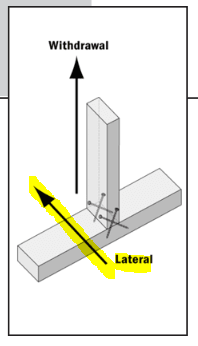I've dug myself into a deep hole of confusion on a topic that is probably very routine and simple: How do you apply the NDS equations to check a toenail connection subject to both withdrawal loading and lateral loading?
Instead of a sketch of this situation, refer to to the 3D image in figure 1 in the AWC Design Aid 2 document here: Link
The particular connection I'm designing/checking is as depicted in the link. I have a 2x6 DF-L parapet stud toe-nailed to a 2x6 wall bottom plate (in the structure there is also a knee brace to brace the parapet stud, but that is not important). The toe-nail connection is subject to 120 lb uplift/withdrawal and 65 lb shear/lateral. Both forces are small, I realize, but I want to understand the correct application of the NDS provision.
I thought I'd start with NDS Section 12.4.2, which covers Combined Lateral and Withdrawal Loads for Nails and Spikes. However, based on the definition of variable "alpha", this seems to pertain to the situation where the fastener is loaded at an angle to the wood surface. Does that apply in my case? Would I simply find the angle of the resultant measured relative to the vertical stud axis? Or relative to the horizontal plane of the main member (wall bottom plate)? It doesn't seem right to do this based on the definition for "alpha". Thoughts?
Instead of a sketch of this situation, refer to to the 3D image in figure 1 in the AWC Design Aid 2 document here: Link
The particular connection I'm designing/checking is as depicted in the link. I have a 2x6 DF-L parapet stud toe-nailed to a 2x6 wall bottom plate (in the structure there is also a knee brace to brace the parapet stud, but that is not important). The toe-nail connection is subject to 120 lb uplift/withdrawal and 65 lb shear/lateral. Both forces are small, I realize, but I want to understand the correct application of the NDS provision.
I thought I'd start with NDS Section 12.4.2, which covers Combined Lateral and Withdrawal Loads for Nails and Spikes. However, based on the definition of variable "alpha", this seems to pertain to the situation where the fastener is loaded at an angle to the wood surface. Does that apply in my case? Would I simply find the angle of the resultant measured relative to the vertical stud axis? Or relative to the horizontal plane of the main member (wall bottom plate)? It doesn't seem right to do this based on the definition for "alpha". Thoughts?


